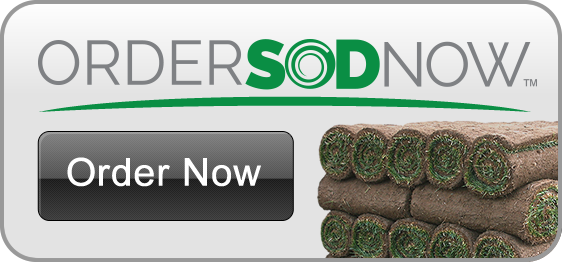FARM FRESH SOD
Growers of Natural Green Space
Grow a Successful Lawn and Garden
Greenhorizons Sod Farms is the homeowner’s obvious choice for everything they need to grow a successful lawn and garden. Our products contain the highest quality ingredients available, and we guarantee that your lawn and garden will flourish.
Premium Kentucky Bluegrass Sod

GHG Premium Kentucky Bluegrass contains the most Elite Kentucky Bluegrass varieties available today! Kentucky Bluegrass has the greatest genetic diversity of the cool season turf grass species. In fact, Greenhorizons goes to great lengths to ensure that the turfgrass we produce is at the top of its class. Darker! Denser! Dwarfer!
Quality Harvest
Ultimate sod-roll quality (no scalps, no cones, no parallelograms) with the ability to roll-out any field imperfections immediately ahead of two individual floating cutting heads, will produce a perfect roll of GHG Premium Bluegrass, every time.
We can be sure of this because our harvester cutter head is mounted in the center of the machine. This eliminates the machine from tracking off course as typical side mounted harvesters do. What's more, automatic steering makes sure every roll is 24" wide each time.
Other factors that contribute to a quality roll is that the cutter head is pulled by our machine and not pushed. Down pressure on the cutting head itself and by an additional roller in front of the cutting head helps create this feeding action. And here’s some welcomed news: this uniform cutting action is so precise it also decreases the weight of a roll, even though it has more area than our previous rolls.
Protect your sod investment through SodGuarantee.com
Make Your Flower Beds & Vegetable Gardens Flourish
BigYellowBag® Black Garden Soil

BigYellowBag® Black Garden Soil has revolutionized gardening in Southern Ontario. A nutrient rich soil blended to perfection at our yard with black loam, peat loam, well-composted manure and a touch of mineral soil. It’s great for use in your flower beds, vegetable gardens, and for over-seeding your lawn. Delivery is a snap. You call, we deliver. It is that simple!
Uses for BigYellowBag® Black Garden Soil:
• Flowerbeds
• Vegetable Gardens
• Over-seeding your Lawn
Delivered in giant cubic yard Bulk Bags or picked up in bulk. Also available in smaller “carry home” bags (pick-up only).
BigYellowBag® Nature's Blend™ Soil
BigYellowBag® Nature’s Blend is an excellent soil for use under sod, filling in holes, leveling out sunken areas in your lawn or a base for a new garden. It's a perfect blend of mineral soil for stability and well composted manure for nutrient value, plus a black loam / peat loam mixture for ease of use. Delivery is a snap. You call, we deliver. It is that simple!
Uses for BigYellowBag® Nature's Blend™ Soil:
• Starting a new Flower Bed or Garden
• Under Sod Leveling
• In Planters and Pots
Delivered in giant cubic yard Bulk Bags or picked up in bulk. Also available in smaller “carry home” bags (pick-up only).
BigYellowBag® Original Bark & Midnight Black Mulch
BigYellowBag® Original Bark & Midnight Black Mulch are the finishing touch for your garden! Use these Decorative well shredded bark mulches for an effective way to reduce weeds, soil and moisture loss and at the same time give your garden that professional look. Delivery is a snap. You call, we deliver. It is that simple!
Uses for BigYellowBag® Original Bark & Midnight Black Mulch:
• Over decorative flower gardens
• Manicured base for trees
• Retains moisture which reduces the amount of water required for the plants
• Helps to control weeds
Delivered in giant cubic yard Bulk Bags or picked up in bulk. Also available in smaller “carry home” bags (pick-up only).
BigYellowBag® Top Dress Mix
BigYellowBag® Top Dress Mix is a high quality mixture of peat and specialty sand blended together at the perfect ratio to provide excellent growth to existing turf and lawns. Originally developed for architects, golf courses and landscapers, our high quality Top Dress Mix is now available to home owners! Delivery is a snap. You call, we deliver. It is that simple!
Uses for BigYellowBag® Top Dress Mix:
• Top Dressing your Lawn
• Over-seeding your Lawn
Delivered in giant cubic yard Bulk Bags.
Unique Lawn Seed Blends Providing Unprecedented Performance
Greenhorizons has been cultivating Southern Ontario's finest turfgrass since 1975. We have dedicated an incredible amount of resources to researching turfgrass cultivars and it has really paid off. Our turfgrass varieties are recognized by international organizations, and they are implemented on some of the nation's most prestigious real-grass fields and golf courses. For more information about Greenhorizons Grass Seed, check out our Grass Seed 101 video!
Professional Lawn Seed
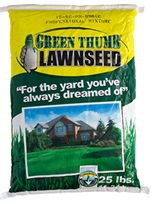
Consists of the following varieties: Kentucky Bluegrass, Creeping Red Fescue, Perennial Ryegrass
• Advantages: High percentage of Kentucky Bluegrass. Looks similar to sod after 18 months. Dark Blue - Green colour with thick carpet like canopy.
• Disadvantages: Takes 18 months to mature. Must have consistent moist conditions for 12 - 14 days to germinate.
Available Bag sizes: 2.2 lb (1 kg), 25 lb (11.4 kg), and 50 lb (22.8 kg)
Quicklawn Seed

Consists of the following varieties: Kentucky Bluegrass, Creeping Red Fescue, Annual Ryegrass, Perennial Ryegrass
• Advantages: Germinates very quickly. Provides a good cover the same season it is planted. Has a percentage of larger seeds so not as dependent on moisture for germination. Great for a quick fix.
• Disadvantages: Lighter in colour with thinner blades. More vertical growth may require more mowing. Not as much of a manicured look.
Available Bag size: 50 lb (22.8 kg)
BigYellowBag® Overseeding Blend Lawn Seed
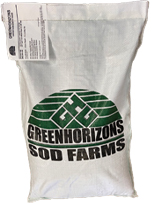
Our Selected blends of grass cultivars will give you professional results: thick green grass. Seed coating provides natural wicking action to the seed for improved germination in low moisture conditions.
Our Lawn Seed is a selected blend of Kentucky Bluegrass, Creeping Red Fescue and Perennial Ryegrass mixed to suit our local Southern Ontario climate and a variety of turf requirements.
It is fast germinating so that it will fill in those bare spots quickly! Within 18 months, your grass can be thick and dark blue/green in colour -- just like sod! For best results use with BYB 10-25-10 Fertilizer
Available Bag size: 10lb (4.54 kg)
Greenhorizons® Premium Lawn Fertilizer
An important part of a great lawn all season long.
When is the best time ... and how often?
For the best results, use a good fertilizer like our GHG 16-16-16 (triple sixteen). It should be applied 3-4 times per year at the beginning of every season. Just before a rainfall is best. We use this same fertilizer mix in our sod fields. It is a well balanced fertilizer with lots of root and plant cell strength builder. It is important to protect your lawn against heat, stress and traffic and triple sixteen can do just that.
Greenhorizons 16-16-16 Fertilizer
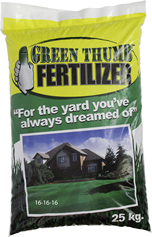
(Triple Sixteen) is a well balanced fertilizer with a lot of root and plant cell strength builder which helps to protect your lawn against heat, stress and traffic.
1st number is nitrogen; greens and promotes top growth
2nd number is phosphorous; keeps roots strong
3rd number is potash; builds cell strength to fight drought and traffic
16-16-16 is not a slow release fertilizer; it must be watered into the ground.
Greenhorizons 10-25-10 Starter Fertilizer
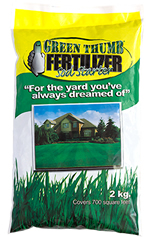
This fertilizer is a starter fertilizer. The high middle number (phosphorous) promotes root growth.
Should be used under new sod or mixed with dirt approximately ½ inch at time of seeding.
The bag size is 2kg and will cover approximately 700 square feet.
Greenhorizons 8-32-16 Starter Fertilizer
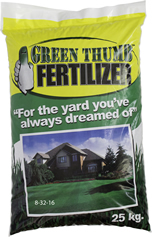
This starter fertilizer is recommend to people who have a large area to seed or sod.
Should be used under new sod or mixed with dirt aproximately ½ inch at time of seeding.
The bag will cover 6,500 ft 2 and weighs 55 lbs.
BigYellowBag Professional 30-5-10
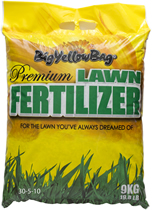
This fertilizer is made of three different slow release nitrogen sources. Fertilize three times a year. It releases gradually over 10-12 weeks. It creates more manageable mowing (less growth spikes causing lots of top growth). This fertilizer does not need to be watered in.
• Use if you are happy with the thickness of your lawn and want to keep it healthy
• Has almost double the Nitrogen
• Will not Burn
• Steady healthy growth pattern
• Only required 3 times per year
• Handy 9 kg bag easy to handle and (carry covers 3000 square feet)
• 6.5 lbs per 1000 square feet or 3 kilos per 1000 square feet
Lawn & Garden Tips
Relieving Compacted Turf
To relieve compacted turf without excessive injury to grass plants has been a formidable chore until recent years when power driven aerators were developed. Today, aerators of many types and sizes are available. They usually have prongs or knives, which pierce the sod to a depth of two to three inches, or they have hollow tines that extract plugs of soil. In either case, the effect is to open up or "aerate" the soil, allowing water, air and nutrients to reach the turf roots.
If you are an average homeowner, you may not want to invest in aeration equipment. You will be wise, however, to give your lawn the benefits of aeration. Call your landscaper or garden centre for information on lawn services or rental companies that have appropriate units. The gratifying results achieved from aeration — plus the savings realized in water and fertilizer, will easily justify the cost.
Fall is the best time for aeration unless you have irrigation, then any time is suitable.
Healthy turf will withstand infestation and recover faster than neglected turf. Here are some guides for healthy turf:
• Use enough fertilizer to keep grass growing vigorously - but avoid the extreme of over stimulation.
• Mow before the grass gets too tall.
• Cut no more than one inch of the leaf surface at any one time.
• Keep your mower sharp.
• Don't allow clippings to accumulate to the extent that they form a mat.
• Remove thatch as required.
• Avoid frequent watering which tends to keep the grass wet.
Feeding Your Lawn: Three Easy Steps
Step 1:
First measure your total lawn area and calculate the square footage (length x width = square footage).
Step 2:
If you’re using our 16-16-16 mix you won’t need as much. The right amount is applied at 8 lbs. per 1,000 sq. ft. Take your total square footage and divide by 1,000. Then multiply by 8. This is how many pounds of 16-16-16 you need to fertilize your whole lawn.
Step 3
Now you can begin spreading. Divide the calculated amount of fertilizer you need in half. In a criss-cross pattern, spread one half in one direction and the second half in the opposite direction.
Establishing New Lawns
Professional Seed and Sod Starter like 8-32-16 and 10-25-10 are good because new SEED or SOD thrive on high phosphorous fertilizers (middle number) while too much nitrogen (first number) could burn the new roots if not careful.
Step 1:
Prepare the Soil by removing existing weeds, grasses and debris.
Step 2:
For a light loose seed bed, cultivate the soil to a depth of 6 inches. This is an ideal time to add organic matter. Cover the desired area with a 2 inch depth of BigYellowBag® Black Garden Soil and work it into the 6 inches of soil.
Step 3:
Incorporate “Professional Seed & Sod Starter” fertilizer into the prepared seed or sod bed and carefully follow the directions on the bag.
Step 4:
Now your soil is well prepared for the SEED
Quick Guide: 8-32-16 and 10-25-10 Fertilizers
The perfect seed and sod starter fertilizer. Use to establish new sod or a freshly seeded area. This fertilizer is high in phosphorous (middle number) which promotes root growth.
• One bag of 10-25-10 will cover the area of one skid of sod
• 8-32-16 available in 25 kg / 55 lb. Bags
• 10-25-10 available in 2 kg / 4.4 lb. Bag
Protecting Your Investment from Grubs
White grubs are considered the number one lawn insect pest in Ontario. They have the potential to inflict serious damage to home lawns when populations reach a significant level.
White grubs are a general term used to describe the larvae stage of scarab beetles. The two main species of grubs that cause damage to lawns in Ontario are grubs from the European Chafer Beetle and the Japanese Beetle. June Beetle grubs are less common but can also inflict serious damage to lawns when they occur. European chafer and Japanese beetle grubs complete their lifecycle in one year, while June beetles take three years to complete their life cycles.
European chafer is the most common grub species found in Ontario. These grubs normally hatch mid to late July (depending greatly on weather and soil temperatures). They begin feeding immediately and continue feeding into late fall. They over-winter as a mature grub in the soil just below the frost line and reappear early in the spring. They feed for a short time in the spring (4-6 weeks) before pupating. Following pupation they change to adults. In late June adult European Chafer Beetles emerge and begin their mating flights. Unlike adult Japanese beetles, adult European chafers do not damage trees or other landscape ornamental plants.
Healthy Lawns can Tolerate a Few Grubs
Grubs cause damage to lawns by feeding on the roots of turfgrass plants. They feed veraciously on turf roots weakening the plants and affecting their ability to take up moisture. Turf damaged by grubs often appears as scattered irregular brown patches. Damage lifts up easily like a carpet, due to the lack of roots holding it in place. Further damage to turf can occur from animals digging for grubs including raccoons, skunks, and birds. This type of damage is often more severe than the damage caused by grubs.
Healthy irrigated lawns can tolerate a few grubs per square foot without showing signs of damage. When populations reach 5-10 grubs per square foot damage can begin to appear especially if the homeowner is not keeping up with their watering practices.
An important defense against grubs and other turf damaging pests is to promote a healthy lawn. A healthy lawn is achieved through proper cultural practices, such as mowing, watering, adequate fertilization and core aeration where necessary. Despite your best efforts to do your part in making sure that these practices are done correctly, grub populations can still build to a level that can cause serious damage to your lawn.
It may be necessary to over-seed on a regular basis with BigYellowBag®'s Lawn Seed (a blend that includes fescue). Read more about Over-seeding in the Lawn and Garden Tips section.
Be sure that leaves and other debris are raked and removed on a regular basis. You want to maintain a maximum amount of air movement and available sunlight in shady areas.
A regular fertilizer program is essential to help maintain your lawn in shady areas. We recommend Greenhorizons' 16-16-16 Fertilizer applied 3-4 times a year on your entire lawn at the beginning of each season.
Be sure to water your fertilizer in or spread before a good rain. Otherwise, fertilizer left on top of grass will evaporate and not be of any use or may burn the blade of grass.
Mowing your lawn properly is one of the easiest things you can do to improve the look and health of your lawn. Here are a couple of key points that many people tend to neglect. Proper mowing will make a good lawn look better, improper mowing can ruin a good lawn in just a few weeks.
The most important point to remember is to keep the mower blades sharp. Nothing defaces grass more quickly than a dull mower. If the blade is not sharp it will tear the grass instead of cutting it. This not only allows diseases to enter but will make the tip of the leaf blade turn brown which in turn can make your whole lawn look brown.
Never take more than 1/3 of the leaf blade off at one given time. If you take more than 1/3 off the leaf blade it; puts the plant under stress, makes it more susceptible to diseases, and can thin the lawn over time. Be sure not to let your lawn grow so tall that it falls over, for it will be difficult to mow and it will smother itself out. We recommend mowing of Kentucky Bluegrasses at 2 1/4 inches tall but no lower than 1 1/2 inches and not over 3 inches high. You can determine the height of your mower blade by placing it on a driveway or sidewalk, and measuring the distance between the blade and the sidewalk.
We do not just mow our home lawns on that special given day once a week. We check to see how much the grass has grown and mow accordingly. By keeping an eye on this you’ll rarely have to rake clippings which can smother a lawn. This also means that you may not need to mow as much in the dry summertime because it does not grow as quickly.
Turf renovation through use of vertical mowers and aerators was once largely limited to golf courses and athletic fields. Now, it has become a common practice for other turf areas, including home lawns.
Fall renovation is in order where it is practical to renew or rejuvenate turf that has been abused but it is still in reasonably good shape. Since roots grow best in the fall and early spring, loosened soil and fertilizer are most needed at those times to encourage turf growth.
The best practice, of course, calls for a continuous management program to prevent deterioration to the extent that it required renovation. Such a program would include: elimination of compaction; application of fertilizer and moisture as grass needs it; and good weed control practices.
How to Seed Your Lawn
Step 1:
Measure your total lawn area and calculate the square footage (length x width = square footage).
Step 2:
Vigorously rake lawn areas to be seeded to remove debris and expose soil for good seed to soil contact.
Step 3:
Spread starter fertilizer over the entire area to be seeded — Greenhorizons' 10-25-10 (4.5 lb. bag) for small areas under 700 sq. ft. or Greenhorizons' 8-32-16 (55 lb. bag) for larger areas over 700 sq. ft. Spread according to your square footage — 8 lbs. per 1,000 sq. ft.
Step 4:
Generously spread seed over the area — 1 kg will cover approximately 450 sq. ft. in the shade and 750 sq. ft. in the sun.
Step 5:
To ensure good seed to soil contact, the areas should be lightly raked. Raking too hard will redistribute the seed and also plant it too deep. The average depth of seed should be between 2 – 5 mm.
Step 6:
Roll the area with a lawn roller to get good seed to soil contact.
Step 7:
Cover the area with some type of light soil, compost or burlap blanket. Be sure not to bury seed more than 1/2 cm.
Step 8: Water, Water, Water!
First watering should be a deep watering to the point that water puddles. This will help saturate the soil profile that can act as reserves later in the establishment phase. Caution must be given to avoid soil erosion. Each watering after the first should be light and frequent, never allowing the surface to completely dry out.
How to Over-Seed Your Lawn
Step 1:
Measure your total lawn area and calculate the square footage (length x width = square footage). For over-seeding - 1kg of BigYellowBag® Lawn seed covers 400 sq.ft. in shade and 600 sq.ft. in full sun.
Step 2:
Vigorously rake lawn areas to be seeded to remove debris and expose soil for good seed/soil contact (VERY IMPORTANT).
Step 3:
For best results, spread starter fertilizer over the entire area to be seeded - Greenhorizons 10-25-10 or 8-32-16.
Step 4:
Measure 40 parts BigYellowBag® Garden Soil to 1 part BigYellowBag® Premium Lawn seed (for example, 40 shovels full of soil to one shovel full of seed) and mix together thoroughly.
Step 5:
Spread this mixture about 1/4 inch over the area to be seeded.
TIP: Divide the mixture in half. Spread the first half evenly over the entire area and repeat. It's better to go over an area a second or third time than to run out of seed before the whole area is covered.
Step 6:
Lightly rake the mixture with a leaf rake to get good seed/soil contact and then roll the entire area (VERY IMPORTANT).
Step 7:
WATER!!! The key to success is frequent watering. Water until the top surface stays moist. Your seed will take four to twelve days to germinate, so water often during that period - 1/4 inch daily for 2 weeks and then cut back to every other day for 2 weeks.
Best Time
For best results, plant BigYellowBag® Premium Lawn seed in late April or May, or during the last 2 weeks of August and first 2 weeks of September. This is when temperatures are cooler and there is more rainfall. If you seed during the drier summer months, you must be consistent with daily watering.
Over the past several years, we’ve been noticing large amounts of snow mold on Homeowners lawns. These grey or pinkish circular patches reek havoc to lawns. The picture shows how it can look very much like the results of dog urine.
Once you notice these rings rake them out immediately! By doing this you allow air to get at the crown of the plants. Otherwise the grass plants could be smothered and have the potential to die.
We would highly suggest a heavy raking over the entire area. Once you’ve “raked out” the snow mold; in a month or so your lawn should bounce back. If it does not, you could repair the lawn by over-seeding. However, if you would like instant repairs you may want to sod the areas that were heavily infested.
The best thing to do in early spring is to rake your lawn even if you aren't sure you have snow mold. A little raking is good, but a good aggressive raking is a lot better. The idea is to get the thatch out of your lawn so it can breathe right down to the crown of the plant. In addition, the heavy snow and ice can cause the blades of grass to lay over, so you’ll want to get them standing straight up. Don’t worry too much about tearing off good blades because the overall results will cover the loss in no time.
The best weed control is a good, healthy turf. When your lawn is thick and vigorous, weeds simply have no place to get started and you have fewer problems.
Here’s what you need to know to get the job done right
1. Prepare the ground before ordering!
It’s IMPORTANT to prepare your ground first before ordering. Your sod needs to be laid within 6-12 hours once you’ve received it.
4 WAYS TO PREPARE BARE AREA
• Rototill, rake debris, level surfaces and lay sod.
• Use “Clear-it’’ (glyphosate) on a thin lawn. When all the green is killed, rake the area and lay sod.
• Rent a small sod harvester and remove the old turf to make way for the new sod. • Set your mower very low to the ground. Mow and rake off debris and put down a thin, good quality top soil before sodding.
2. Grade Surfaces
Carefully level all surfaces to be sodded. Soil surfaces should be 1 inch below walkways, patios and driveways to accommodate sod thickness. A light rolling will show soil depressions or surface irregularities. These can then be leveled.
3. Order Your Sod
Call 905-389-1515 or Order online at OrderSodNow.com
NOTE: We will need 24 hour notice to deliver your sod - excluding Sundays
4. Fertilize the Area
Fertilizer will be used by sod over the next few days as it is watered. Turf starter fertilizer can be applied either on the soil surface or on top of sod after it is down. Apply fertilizer evenly and at the recommended rate. Rake in lightly. Be sure the soil is even and smooth before laying sod. Use Greenhorizons turf starter fertilizer for best results.
5. Lay Sod Within 6-12 Hours
Begin laying sod as soon as possible (within 6 - 12 hours) upon delivery, especially in the spring (May- June) to avoid damage from heating. Sod that will remain stacked on a pallet for an extended period of time must be unstacked to allow air circulation.
Lay the first strip of sod along a straight line using string as a guide. Butt joints tightly- do not overlap edges. When laying the second strip, stagger the joints, much like laying bricks. Use a sharp knife to cut sod to fit curves, edges, sprinkler heads, etc.
6. Water. Water. Water.
Water within 15 minutes of laying the first roll! Do not wait until the entire area is sodded before watering. As soon as a “sprinkler-sized” area is laid, begin watering it. Then go on to the next section. On a hot day, do not leave laid sod for more than an hour without water. On a cooler, overcast day, do not leave it for more than 2 hours.
7. Roll New Sod
Roll your new-GREENHORIZONS lawn to even out the turf joints and to ensure good contact between the turf roots and soil. Rolling is also effective in eliminating air pockets.
REMEMBER: Keep your new-3-D SOD BLEND well watered for at least 2-3 weeks. This will assist the turf edges to knit and the roots to establish. Now you are ready to enjoy years of pleasure with your beautiful new GREENHORIZONS lawn!
Water, fresh air and nutritional food are important for your overall health, and it’s no different for plants. If you want to have a lawn that’s the envy of the neighbourhood next spring, it’s important to make sure your grass is getting what it needs in the fall.
One thing you can do to help your lawn be as healthy as possible is top-dress your lawn. This is where you add a thin layer of a blended soil mixture to your lawn. The sandy texture of BigYellowBag's high grade TOP DRESS mix is designed to improve water, air and nutrient movement into the soil (infiltration) and within your lawns root-zone (percolation). The organic component of the soil carries micro-organisms which produce and carry key nutrients into the soil.
Top dressing aids in creating natural organic food for your lawn through microbial activity. By raking or sweeping the Top Dress mix into the thatch layer, it speeds up the process of allowing micro-organisms and worms to feed on that rich thatch layer then carry key nutrients like nitrogen, phosphate and potash back into the soil, for a healthy lawn.
Optional over-seeding may also be combined to thicken up the bare areas.
Top dressing is best done in the fall, when your grass has time to grow through three or four mowings before the frost. For the best results, work in sections. Put a few shovelfuls of Professional Top Dress Mix onto your lawn in rows and spread it out with something flat, like the back of a garden rake or a broom. It should be about half an inch or less over the existing grass, no more than an inch. Work the Professional Top Dress Mix in until you can see the grass poke through. You can use the tine side of the rake, if that helps.
It’s a good idea to water your lawn when you’re done applying the Professional Top Dress Mix, to help everything settle. After it’s had a day or two, go back out with your rake and smooth out any hollows or bumps.
Finally, make sure that on the last two mowings of the season, you have your lawnmower blades set to the lowest setting. This allows more sunlight to reach the crown of the grass and there will be less of the grass’ blade to turn brown in the winter.
Step 1
Mow your lawn short.
Step 2
Remove the lawn clippings and any other debris.
Step 3
Distribute the Topdress Mix evenly in rows around your lawn. Using the back of a rake (don’t want to rip into the surface) push and pull the Topdress.
Step 4
Using a broom or garden rake, brush the soil so it moves through the blades of grass.
Step 5
You want to make sure you allow the grass to poke through the Topdressing Mix. You do not want to smother it.
Step6
Water lightly 3 X’s daily for seven to ten days or until seed is germinated.
OPTIONAL:
Overseed - to give your lawn thicker growth, better colour, control thatch and weeds.
Fertilizer - to feed soil. Replace nutrients lost through winter damage, traffic, erosion
INFORMATIONAL AND HOW-TO VIDEOS
Hamilton
Hamilton Sod
2907 Upper James St.
Mount Hope, ON
L0R 1W0
(905) 389-1315
Cambridge
Compact Sod
1625 Kossuth Rd.
Cambridge, ON
N3H 4R6
(519) 653-7494
London
Middlesex Sod
4227 Dundas St.
London, ON
N5V 5C6
(519) 268-7518
Niagara (Fenwick)
Young Sod Farm
360 Foss Road.
Fenwick, ON
L0S 1C0
(905) 892-2681
Oakville - Outlet
Ontario Sod
2376 Royal Windsor Dr.
Oakville, ON
L6J 7Y2
(905) 849-1915
Halton
Halton Sod
(905) 878-1011
Brampton
Brampton Sod
(905) 450-5715
Niagara - Outlet
Niagara Sod
130 Bunting Rd.
St. Catharines,
ON L2P 3G5
(905) 984-8448
Hamilton
Hamilton Sod
2907 Upper James St.
Mount Hope, ON
L0R 1W0
(905) 389-1315
Cambridge
Compact Sod
1625 Kossuth Rd.
Cambridge, ON
N3H 4R6
(519) 653-7494
London
Middlesex Sod
4227 Dundas St.
London, ON
N5V 5C6
(519) 268-7518
Niagara (Fenwick)
Young Sod Farm
360 Foss Road
Fenwick, ON
L0S 1C0
(905) 892-2681
Oakville - Outlet
Ontario Sod
2376 Royal Windsor Dr.
Oakville, ON
L6J 7Y2
(905) 849-1915
Halton
Halton Sod
(905) 878-1011
Brampton
Brampton Sod
(905) 450-5715
Niagara - Outlet
Niagara Sod
130 Bunting Rd.
St. Catharines,
ON L2P 3G5
(905) 984-8448


